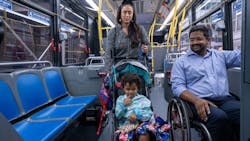MTA announces citywide open stroller pilot program
An open stroller pilot program was announced by the Metropolitan Transportation Authority (MTA) for buses across all five boroughs.
Starting next week, buses on the M31, B1, Bx23, Q50, Q12, S53 and S93 routes will begin to be outfitted with a designated space for one open stroller. By early October, every bus that serves these routes will have a designated stroller space in place.
The buses that are part of the pilot program will be identified with a stroller decal on the outside of the bus that customers can easily see before boarding. Once inside the bus, the designated space will be identified with a similar decal.
“When I arrived at the MTA, I made it clear that my definition of accessibility was a broad one, one that includes parents, children and seniors, as well as riders with disabilities,” said MTA Chief Accessibility Officer and Senior Advisor Quemuel Arroyo. “This pilot program was a direct result of the MTA Accessibility and Bus teams, disability advocates, parents and bus operators coming together in a collaborative working group to address a concern that customers felt strongly about.”
The stroller space will allow customers with young children to board and ride the bus without needing to fold their stroller first. The stroller space will be either an open space near the rear door, or a space created by flipping up two side-by-side seats, depending on the bus model. The designated open stroller spaces are entirely separate from existing priority seating for bus riders with disabilities. A bus rider boarding with a wheelchair will still have the same number of designated spaces.
“When I first arrived, I said we need to try a stroller policy that works for customers, and it can't take years, we need it now,” said NYC Transit President Richard Davey. “This pilot comes at the right time for stroller moms, stroller dads and others who need to bring toddlers onto buses and aligns with our North Star to improve customer satisfaction.”
The pilot is expected to run for six months on the 142 buses that serve these seven routes to gauge ridership. The two seat options -- seat removal versus the flip-up seating space -- will be evaluated to identify the best solution and any potential safety concerns.
The working group that developed the pilot included disability advocates, parents, bus operators and members of the MTA’s Accessibility and Customer Experience teams and NYC Transit’s Department of Buses. The group met throughout the spring and summer and reviewed seating options and stroller policies from other transit systems.
“We've heard from many parents and caregivers about the difficulty of folding strollers, and how it often deters customers from riding the bus,” said New York City Transit Senior Vice President for Buses Frank Annicaro. “By creating a designated space for one open stroller on these pilot buses, we hope to make the ride easier for caregivers and speed up the bus for everyone by eliminating the need to wait for caregivers to safely fold strollers and get situated on the bus with a child.”
For buses not participating in the pilot, the current stroller policy will remain in effect.
